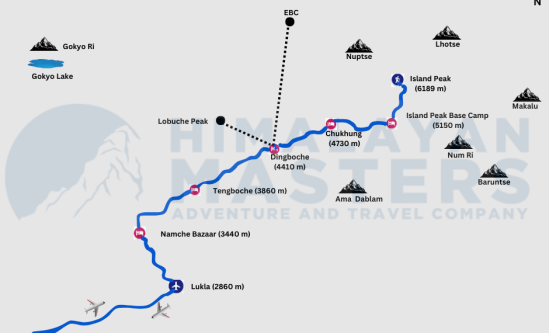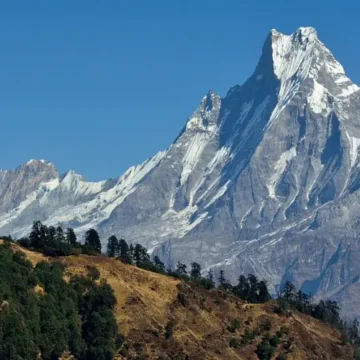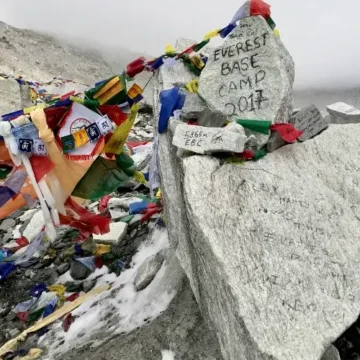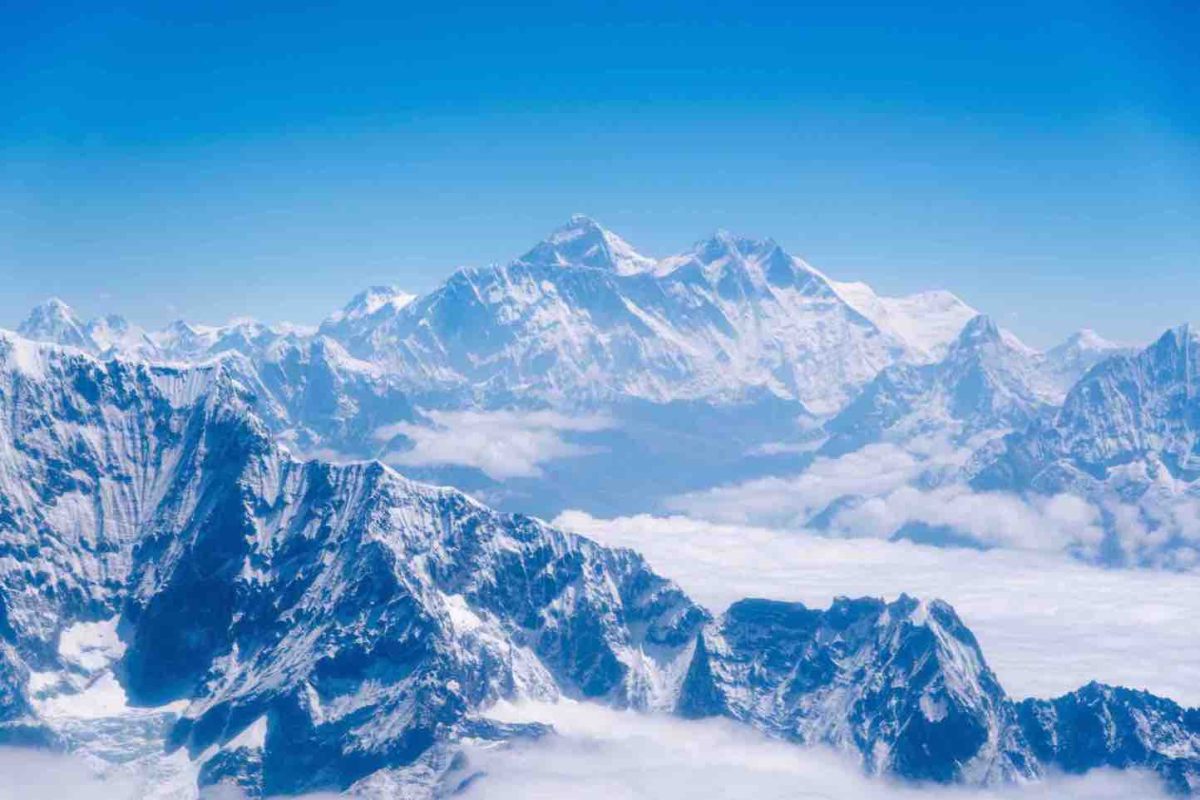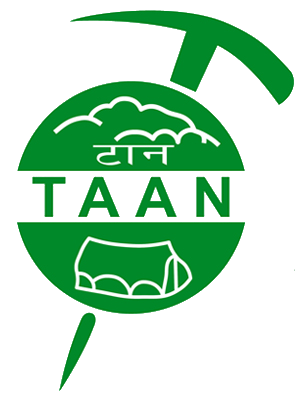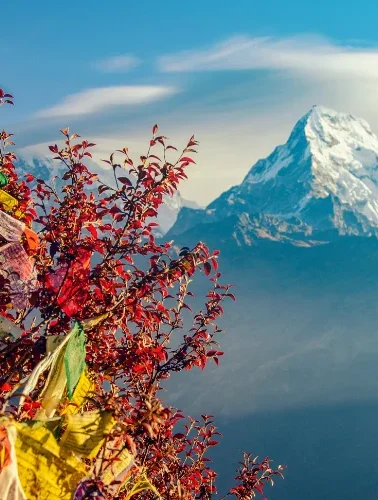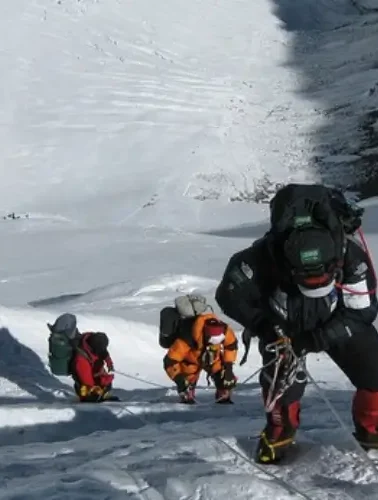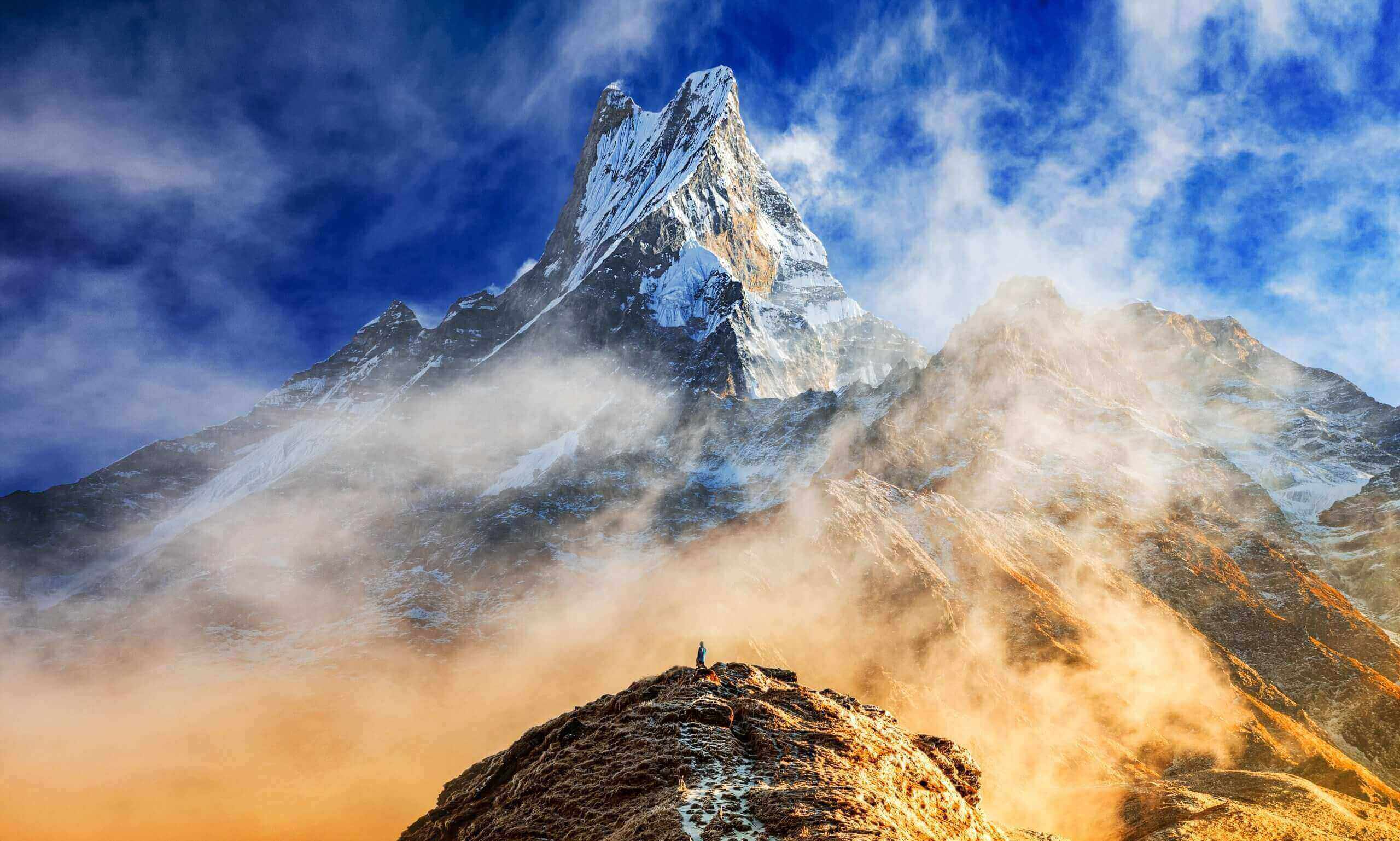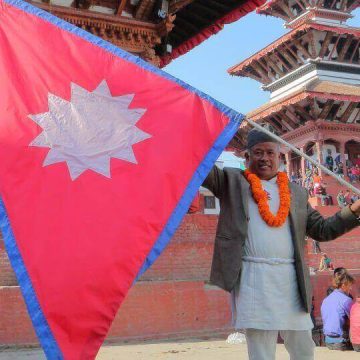
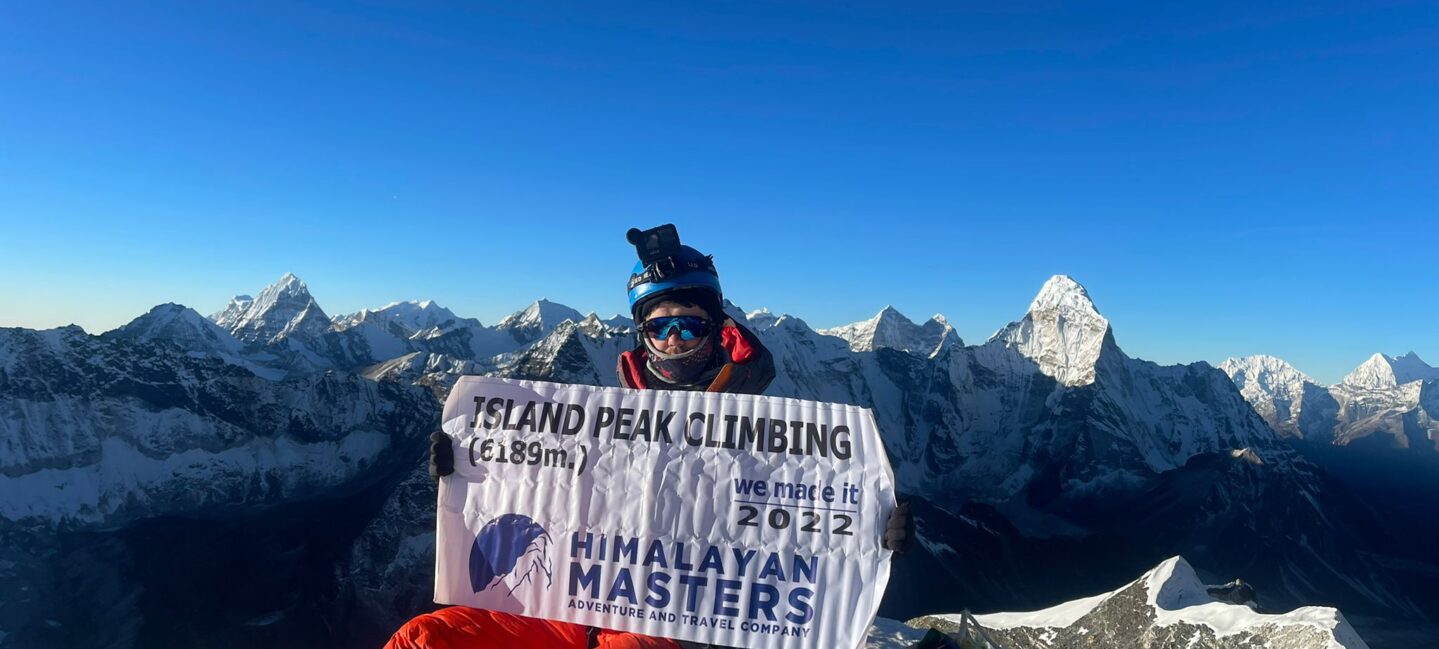
- TRIP DURATION
- 16 Days
- MAX. ALTITUDE
- 6200 meters
- TRIP GRADE
- hard
- LODGING
- Tea house and tent
- BEST SEASON
- Springs and autumn
- MEALS
- Breakfast lunch dinner
- COMMUNICATION
- Local sim card
- PER DAY WALK
- 5 to 6 hours
Island Peak Climbing
Among Nepal’s mountain climbers and experienced trekkers, Island Peak is the best trekking peak. Located in the Khumbu region, this high peak in Nepal, at 6,160 meters, is the raw form of adventurous travel. Also called Imja Tse, this is a tough challenge for newbie climbers. Even Edmund Hillary and Tenzing Norgay, the first successful climbers of Mount Everest, used Island Peak as their practice peak.
And this spectacular peak waits for your arrival. Keep your doubts away and listen to the calling of the mountains. Island Peak is regarded as Lhotse’s extension, separated by a small col. This means the exciting climb to Imja Tse offers an enjoyable trek and the spectacular scenery of the Himalayas, including Everest, Lhotse, Makalu, and many other peaks above 8000 meters.
Along with a rejuvenating experience in the mountains, the tour also offers insight into the Khumbu region’s unique Sherpa culture and rich biodiversity. It’s an equally prodigious journey, whether an Everest Base camp with an Island Peak climb or only Island Peak climbing.
There are two ridges one can use for the Island Peak climb route.
South Ridge
The base camp of Island Peak is located at Pareshaya Gyab at an altitude of 5,150m. The base camp lies between Imja Tse and Imja Glacier. Although the base camp is an excellent place for climbing preparation, climbers prefer to settle at the high camp. Walking along the broad, open gully leading to the high camp is an effortless journey. From there, the challenging climb, along with the steep snow and ice ramps, finally leads us to the summit.
North Ridge Route
The first climb to the island peak from the northern ridge was done in 1958. This route, discovered by the team of two Sherpas, Alf Gregory and Dick Cook, climbs from the height above the col. Getting on the right bank of the Imja Glacier, we move above Lhotse Sar Glacier. Finally rising to the northwest over snowy slopes, we continue to the south and the final summit pyramid. The north ridge route is graded PD+ by the climbers and is relatively tricky.
Island Peak Climbing Highlights
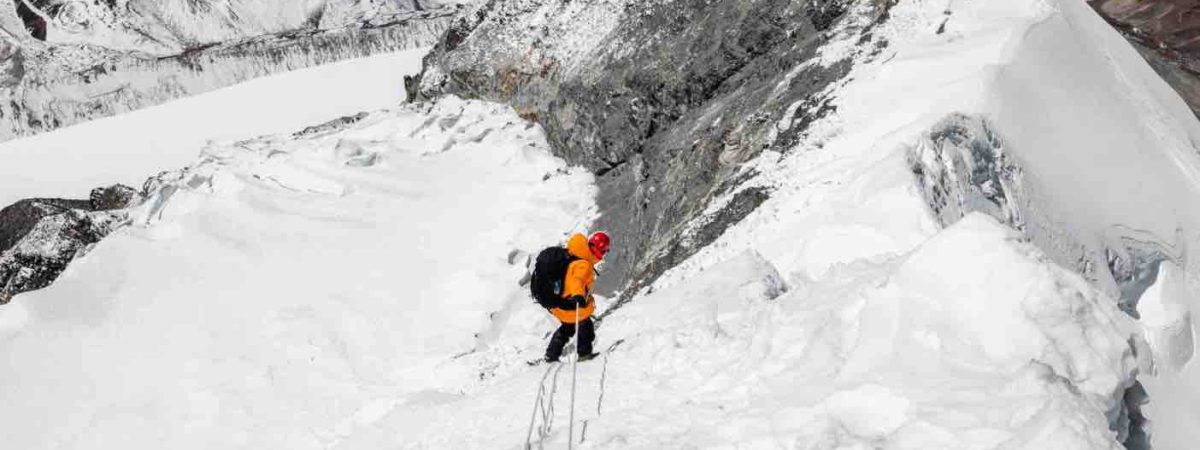
Conquer one of the highest trekking peaks in Nepal, i.e., the ultimate adventure, without needing any pro-mountaineer skills.
- Gain training and experience for climbing higher mountains in the future
- Commence the trek with a thrilling flight to Lukla Airport, one of the highest-altitude airports in Nepal
- A great chance to witness the beautiful Khumbu Icefall
- Visit the Chukung Valley with its amusing 360-degree views of the mountains.
- Trace the classic Everest Base Camp route to visit the Namche Bazaar and the Tengboche Monastery.
Can You See Everest From Island Peak Climbing?
Yes, you can see Mount Everest during this island peak climbing itinerary. Everest becomes visible from Namche and appears large as you move closer to the mountains. Along with Mount Everest, you can witness dozens of other peaks. Here are other peaks you can see during the island peak climb:
- Nuptse (7,879m),
- Lhotse Middle Peak (8,410m),
- Lhotse Shar (8,383m),
- Makalu (8475m) in the east,
- Baruntse, and
- Amadablam in the south
PS: Check Manaslu Circuit Trek
ITINERAY
Day 01: Arrival at kathmandu
Your first day in Nepal will already be fun. After you land at the airport, a private car will pick you up and drive you through the smooth streets of Kathmandu. Getting to the hotel in Thamel, you can take your time recovering from jet lag. In the evening, we meet some team members and gather for an exciting welcome dinner. There might be some briefings and fun sessions.
Overnight in Kathmandu
Accomodation : Hotel
Day 02: Pre depature meetings in Kathmandu
For peak climbing in Nepal, it is compulsory that you take an extra day in Kathmandu so that you can allocate all the gear, take some training, and go through some guiding sessions before you move to the mountain. Also, if you have some extra time, you can explore the old heritage sites around Kathmandu and have a fun, exciting day before we move toward the trek.
Meal : Breakfast
Accomodation : Hotel
Day 03: Fly to Lukla and Trek To Phakding
Quite early in the morning, a driver picks us up from the airport and drives us to the domestic airport. On a morning flight, we can clearly see the mountains smiling at us while we land at Lukla Airport at 2,845 meters. We met our sherpas and porters here, starting the trek as a group.
From Lukla, the crew starts the walk via the small villages of Chheplung and Ghat. Walking the route of the Dudh Koshi River, we hike to Sano and Thulo Gumela. Even on the first day, we get to witness the monasteries of Drangdrak Gompa and Pema Choling Gompa. After a couple of hours, we will be resting at the tea house of Phakding.
Overnight in Phakding
Meal : Breakfast Lunch Dinner
Accomodation : Guest House
Walking / Driving : 5/6 hours trekking
Day 04: Trek to Namche
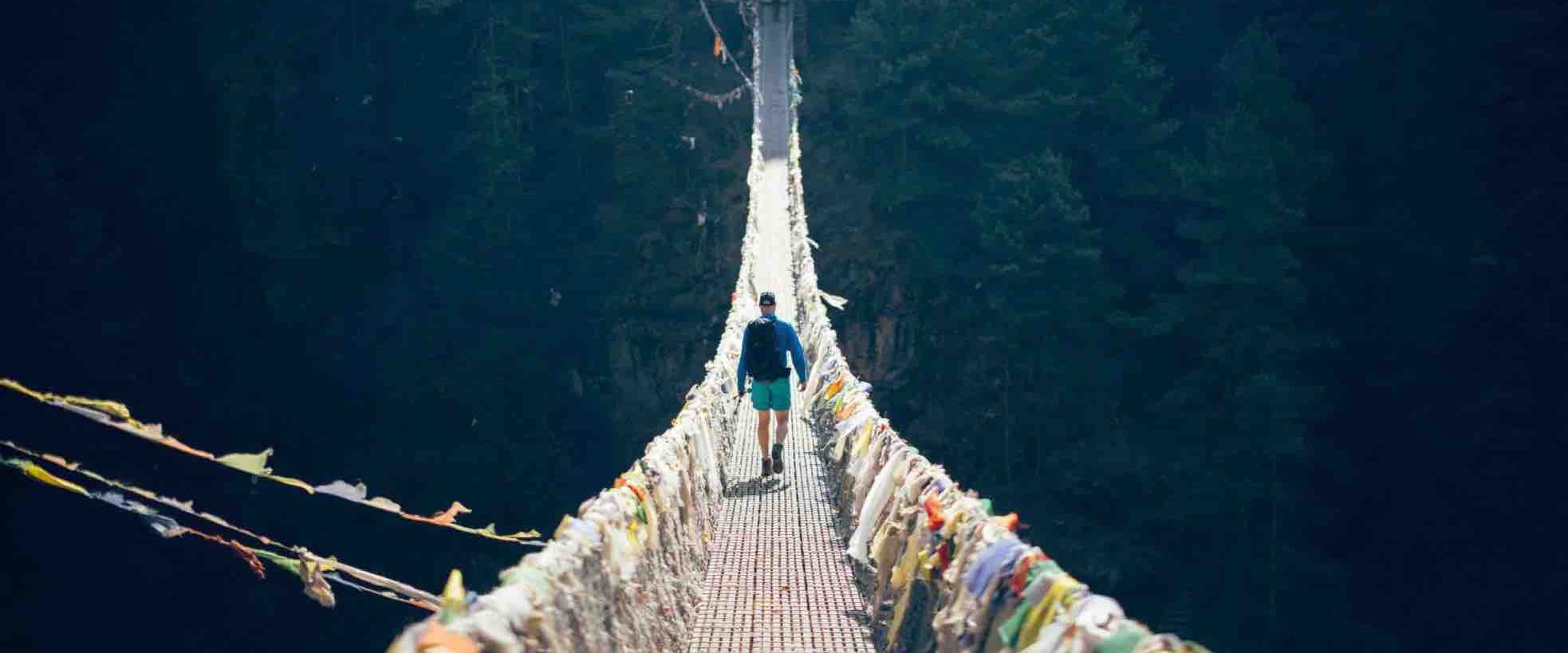
The 5th day of the trip is an exciting walk through the subtropical forest. It’s your chance to see Nepal’s rear flora and fauna before you get to alpine grassland. We also get to cross thrilling suspension bridges like the Hillary Bridge. In Monjo, we stop to get our permits checked and start climbing upward. The final tough walk brings us to the Namche bazaar by the evening. This traditional trading town of Khumbu has a lot of restaurants and bars for a wonderful night.
Overnight in Namche
Meal : Breakfast Lunch Dinner
Accomodation : tea house
Walking / Driving : 5 to 6 hours trekking
Day 05: Trek Namche to Tengboche (3,855m)
As we hike over the Namche village, we can witness the stunning Everest, Nuptse, and Island peaks. As we walk along the Dude Koshi River, we walk via the thick alpine forests towards the village of Phunki Thenga. A steep ascent from here takes us to the Tengboche village, which has the largest and most beautiful monastery in the Khumbu zone. We pray at the monastery and spend a night here during Island Peak Trek.
Meal : Breakfast/ Lunch/ Dinner
Accomodation : Tea House
Walking / Driving : 4-5 hours
Day Day 06: Trek Tengboche to Dingboche (4,360m)
After we left Tengboche, we first hiked via the forested path towards Pangboche. Crossing many chortens and decorations on the way, we enter the Imja Valley. Then, it’s a short and fun descent before we walk down to the Dingboche village. Dingboche is often used as a resting place with a better view of the Island and Lhotse Peak for Island Peak Trekking.
Meal : Breakfast/ Lunch/ Dinner
Accomodation : Tea House
Walking / Driving : 5-6 hours
Day 07 : Dingboche to Chhukung (4735m)
After breakfast on the 7th day of Island Peak climbing, we walk to the Chukhung Valley via the Imja Khola Valley. As you walk upwards, we move towards Mt. Lhotse and Ama Dablam. Chhukung, the higher Himalayan zone, only has a few lodges where we can spend our night.
Meal : Breakfast/ Lunch/ Dinner
Accomodation : Tea House
Walking / Driving : 3 hours
Day 08: Rest Day in Chukung
On Chukung, we spend a rest day for acclimatization. The plan is to spend a day here on activities such as climbing boots, crampons, ice axes, harnesses and more. Such training will be helpful while you are in the risk-prone areas around the mountains. Get yourself boosted on a resting day so that you can prepare yourself to climb the Island Peak.
Meal : Breakfast, lunch and dinner
Accomodation : Tea house
Walking / Driving : 5 to 6 hours trekking
Day 08: Trek to Island Peak Base Camp

From Dingboche, our initial climb is towards the Imja valley. Witnessing the stunning Lhotse and Nuptse (mountains among the world’s ten tallest), we continue from Chukung to Island Peak Base Camp. After walking for hours in the southeast direction on the path along the stream, we soon reach our destination. Here, we set up camp with the team’s help and let our bodies rest. A night at the base of the mountains will definitely be magical.
Overnight in Island peak base camp
Meal : Breakfast Lunch Dinner
Accomodation : Tent
Walking / Driving : 4 hrs
Day 09: Early morning Summit Island Peak (6189m) and back to Chunking
Today is the most challenging and exciting day of the entire Island Peak climbing journey. We start the day early in the morning, i.e., before sunrise. Fully equipped, we began to hike to the summit before noon. Since the wind after midday is mighty, we plan to reach the summit before that.
The guide will assist you in the difficult section, so listen to him properly. From the peak, we can witness the breathtaking panorama of the mountain vistas.

We start climbing at 4 am in the morning even earlier so that we can get to the peak before noon. We will tackle several technical sections and head towards the summit. The guide will help you with ropes and crampons when needed. The views of Everest, Lhotse, Makalu, and Baruntse look amazing from here. After some moments here, we slowly walk down the tricky area and reach base camp. If possible, we walk to Chukung so that we can spend our night in the warm tea house.
Overnight in Island peak base camp
Meal : Breakfast Lunch Dinner
Accomodation : Tea house
Walking / Driving : 11 hours climbing
Day 10: Trek down to Dingboche
Walking duration: 3 hours
From the island base camp, we slowly walk down to Dingboche. It’s a reverse walk from Chukung to Island Peak Base Camp. Walking through this alpine grassland with no human settlement has its kind of fun. In a couple of hours, we will be resting in the beautiful tea house of Dingboche.
Overnight in Dingboche
Meal : Breakfast Lunch Dinner
Accomodation : Tea House
Walking / Driving : 3-4 hrs
Day 11: Trek to Tengboche
Walking duration: 3 hours
Crossing the familiar paved path of Phunki Tenga, we soon reach the village of Tengboche. The return journey will be even more interesting as we only walk a few hours and spend a lot more time capturing photos and interacting with the locals.
Overnight in Tengboche
Meal : Breakfast Lunch Dinner
Accomodation : Tea House
Walking / Driving : 4-5 hrs
Day 12: Trek to Namche
Walking duration: 4 hours
Walking downwards, we will again be back to Dudh Koshi River. You can witness the drastic change in landscape- the alpine grassland now changes into a thick forest. After about 4 hours of easy walking, we will be back to Namche- this place is already familiar to you.
Overnight in Namche
Meal : Breakfast Lunch Dinner
Accomodation : Guest House
Walking / Driving : 5-6 hrs
Day 13: Trek to Lukla
From Namche to Lukla, the path moves steeply downward. Like earlier, we cross Mani-stone, chortens, prayer flags, and a beautiful pine forest, leading us to Monjo and finally to Lukla. The Island Peak climb ends here, and it’s time for a celebration.
Overnight in Lukla
Meal : Breakfast, Lunch and dinner
Accomodation : Tea house
Walking / Driving : 4-5 hrs
Day 14: Fly to Kathmandu
However hard we fall in love with the mountains, it’s time to get back—the agency books your flight from Lukla to Kathmandu in the morning. Leaving your team and the mountains, you get to Kathmandu within 25-mins.
Again, a car picks you up at the airport and drives you to the hotel in Thamel. In the evening, it’s celebration time. We raise a toast for the successful conquest of the Island Peak and enjoy a final meal together.
Overnight in Kathmandu
Meal : Breakfast and Lunch
Accomodation : Hotel
Walking / Driving : 30 min flight
Day 15: Departure
So, this is the end of your excellent Everest Base Camp Luxury Trek. A driver will take you to the airport as per your flight time. Complete your customary formalities and get on a plane back home.
Also Read: Nar Phu Valley Trek In Nepal
Meal : Breakfast
Fixed Departure
| Trip Date | Trip Status | |
|---|---|---|
| 01-09-2024 | GUARANTEED | book now |
| 07-09-2024 | GUARANTEED | book now |
| 13-09-2024 | GUARANTEED | book now |
| 17-09-2024 | GUARANTEED | book now |
| 20-09-2024 | GUARANTEED | book now |
| 25-09-2024 | GUARANTEED | book now |
| 27-09-2024 | FULL | book now |
| 01-10-2024 | LIMITED | book now |
| 07-10-2024 | GUARANTEED | book now |
| 13-10-2024 | GUARANTEED | book now |
| 20-10-2024 | LIMITED | book now |
| 27-10-2024 | LIMITED | book now |
| 01-11-2024 | OPEN | book now |
| 06-11-2024 | OPEN | book now |
| 16-11-2024 | OPEN | book now |
| 24-11-2024 | OPEN | book now |
| 30-11-2024 | OPEN | book now |
| 01-12-2024 | OPEN | book now |
| 10-12-2024 | OPEN | book now |
| 15-12-2024 | OPEN | book now |
| 20-12-2024 | OPEN | book now |
| 25-12-2024 | OPEN | book now |
| 30-12-2024 | OPEN | book now |
include / exclude
Trip Cost Includes
- Private car pick-up and drop-off at all International and domestic airports
- A professional English-speaking trekking guide during the trekking
- Three Night Accommodation in Kathmandu with Breakfast. (3-star Hotel)
- A professional Proter for trekking and climbing with his food, accommodation and insurance
- Breakfast, Lunch and dinner during your trekking and expedition
- Basic twin-sharing tea house accommodations In the mountains.
- Sagarmatha National Park permits
- Khumbu municipality permits
- Island peak permits
- Kathmandu to Lukla to Kathmandu airfare
- Guide Flight Ticket
Island Peak climbing Cost includes
- a one-night tent stay at the island peak base camp
- and one-night tent accommodation at Island peak high Camp.
- Breakfast, lunch and dinner during base camp and high camp, tea and coffee are unlimited.
- A climbing sherpa for island peak 2 sherpa for three clients (Private guide)
- Guide insurance
The Complimentary service from The Himalayan Masters
- -a 25-degree sleeping bag during the trip.
- down jacket during the trip.
- Water bottles and purification tablets by Himalayan Masters
- first aid kit box.
- Himalayan Masters Brand Duffle Bag for the Trip
- Himalayan Masters Brand Trekking T-Shirt and Cap
- Farewell dinner in Kathmandu by Himalayan Masters Team
Trip Cost Excludes
- an international flight ticket
- Tips for Climbing guides and porters and base camp staff
- Lunch and dinner in the mountains
- Wifi, battery charging, and hot showers in the mountains.
- Travel Insurance
- Your personal expenses
Other things that have not been mentioned above are also on the exclusion list.
useful info
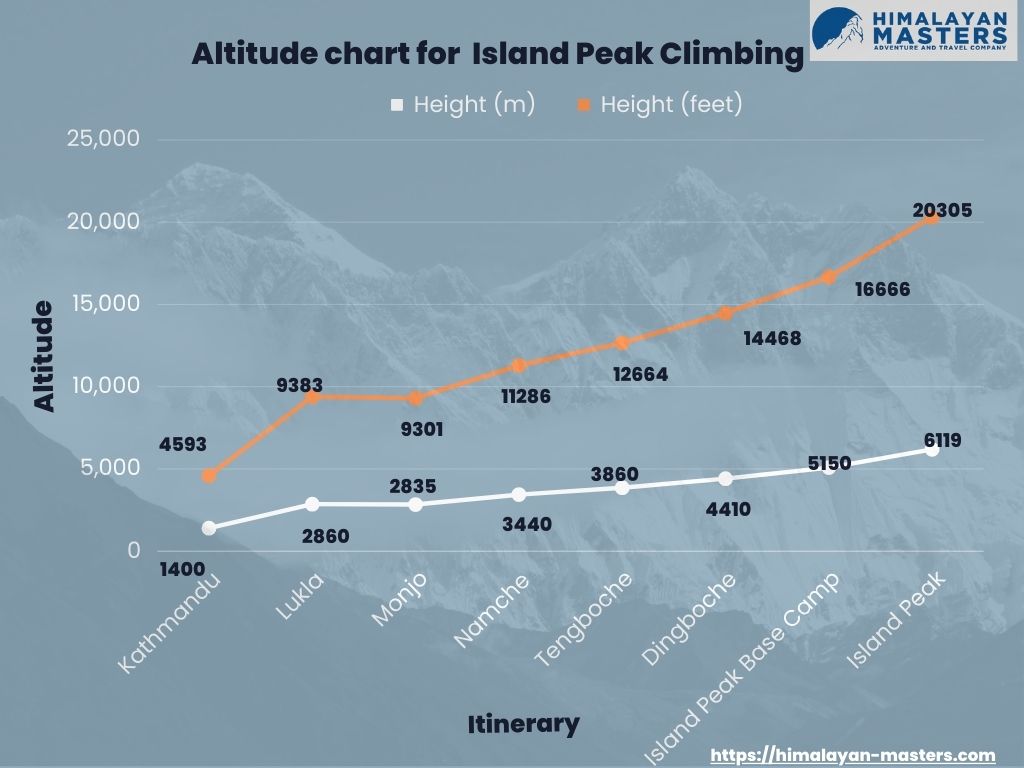
Island Peak Climbing cost
The island peak is the ideal option for anyone wishing to climb a peak higher than 6000 meters, and climbing it with Himalayan Masters would cost you USD 2305 in total. We have produced an in-depth essay regarding the cost of climbing the island peak.
Learn more about the cost of climbing Island Peak
How Difficult is Island Peak Climbing?
This Island Peak climb is not a piece of cake. The long climb at 6,189m above sea level comes with some difficulties you cannot consider. Some previous hiking experience, excellent physical health, and a lot of determination are needed to make this island peak climb successful. Further, the most important thing is the guidance from the expert team at Himalayan Masters.
As per the Himalayan masters’ itinerary of 16 days, you will be walking for 6 to 7 hours each day. This is about 12 to 13 hours of walking with 10 to 15 kg of a backpack in rough mountain terrain. The Island Peak climb has alternative up-and-downhill routes with a few steep walks. In some parts, you might need crampons, ropes, and axes.
Further, the journey gets more challenging if you add Mera and Island Peak climbing. Trekking via the rugged path at Island Peak height of 6,160 meters, means your body gets half of the oxygen from that at sea level. Cases of altitude sickness are seen in every one in three people (when precaution is not taken).

Since our itinerary has a lot of rest days and only a few hours of walking per day, you will be safe in our hands. Also, people should keep themselves hydrated, avoid all kinds of alcoholic drinks, and stroll. Further, the island peak climb season also determines the island peak difficulty.
Our Sherpas are mountain experts and guide you well for a safe climb. Similarly, we will have a group of cooks and porters who will assist you in every step. And if something still goes unexpectedly, you can quickly be rescued in a helicopter. In short, you will be safe with the Himalayan masters.
Also Read: Dhaulagiri Circuit Trek In Nepal
Best Time to do Island Peak Climb
Deciding when to go for Island Peak Himalaya is essential for a successful and enjoyable trip. The best times for this adventure are spring and fall.
You’ll experience beautiful landscapes with blooming flowers and clear skies in spring (March, April, May). Daytime temperatures range from 15 to 17 degrees Celsius, while nights can get chilly at -10 degrees Celsius. Autumn, on the other hand, offers stable weather and clear views of the Island Peak Himalaya. Temperatures range from 0 to 15 degrees Celsius during the day, with colder nights dropping to around -15 degrees Celsius by late November.
Avoiding the monsoon season in summer is wise, as heavy rain makes the trails muddy and dangerous. Additionally, the risk of avalanches and landslides increases during this time. Winter months, December to February, are considered off-season due to extreme cold, but with proper preparation, climbing in December can be manageable, offering solitude and peaceful terrain.
Ultimately, the best time for Island Peak Himalaya is autumn and spring. These seasons provide favorable weather conditions, clear skies, and pleasant temperatures, making for an enjoyable and safe climbing experience.
Permits to do Island Peak Climb

To climb the Island Peak Himalaya, climbers need three permits: a Nepal Mountaineering Association (NMA) Permit, a Sagarmatha National Park Entry Permit, and a Local Area Permit (Khumbu Rural Municipality Entrance permit). The NMA Permit allows climbers to climb the peak, while the Sagarmatha National Park Entry Permit grants access to the national park where Island Peak Summit is located. A Local Area Permit is also necessary to enter the Khumbu Rural Municipality area, where the peak is situated. Costs for these permits vary but typically range from $50 to $500, depending on the season and the policies in place.
Food and Accommodation during the Trip
In Kathmandu, we’ll be staying in 3-star hotels on a twin-sharing basis, ensuring a comfortable start to our journey. However, options range from 3 to 5-star hotels, basic lodges, and even hostels if preferred. Single rooms are available at an additional cost but must be pre-booked due to limited availability. Once we trek into more remote areas of Island Peak Trek, our accommodations transition to tea houses in charming villages. These tea houses offer basic facilities with twin-sharing rooms and attached bathrooms, ensuring hygiene and comfort during our stay.
As we continue Island Peak trekking, we’ll spend nights in tented camps, especially at the Island Peak Base Camp. Here, we’ll camp for two days alongside our group, immersing ourselves in the rugged beauty of the mountains. Despite the simplicity of our accommodations, our focus remains on safety and providing the best experience possible. Meals throughout the journey will include breakfast, lunch, and dinner, with a wide variety of options available in Kathmandu, and we will gradually transition to local dishes like Dal Bhat as we ascend in altitude. Our staff ensures we receive nutritious meals to fuel our adventure ahead. Read full food and accommodation in Everest.
Staying hydrated is crucial, especially during long treks in high altitudes. While bottled water is available, it can be pricey, particularly at higher altitudes. We’re encouraged to bring reusable water bottles and purification methods to combat this. Natural springs and taps along the way offer opportunities to refill our bottles, ensuring we stay hydrated throughout our expedition.
Altitude Sickness at Island Peak Himalaya
Reaching the top of Island Peak Elevation, which stands at a height of Island Peak of 6189 meters, brings the excitement of high altitude. But along with this thrill comes the risk of altitude sickness. This happens when your body struggles to adapt to the changes in altitude. To avoid feeling unwell, taking care as you climb is important. Spending nights above 3000 meters during the journey increases the chances of experiencing symptoms like headaches or dizziness.
To prevent this, you can acclimate slowly, drink plenty of water, and get enough rest. It’s also wise to consult a doctor about medication like Diamox, which can help. Your guide will be there to assess the situation and make the right decisions if symptoms become severe. While the itinerary includes two days for acclimatization, the rapid gain in altitude during the climb means there’s still a risk of feeling unwell due to the changes in altitude. So, it’s essential to take precautions throughout the journey of Island Peak height.
Terrain on The Island Peak Trek
The trek begins by following the main path to Everest Base Camp Island Peak, which is well-traveled but can be rocky and uneven sometimes. Once on the mountain, you’ll encounter loose rocks and steep drops, especially as you ascend in the dark starting at 4 am. Hands may be needed for support as you navigate the scree and rocks.
At the snow line, known as “crampon point,” you’ll switch to crampons and ropes for safety. The glacier has many crevasses, some deep, and you’ll cross them using ladders while roped to others.
Next, you’ll reach the base of the headwall, where you’ll switch to fixed lines. These lines need to be checked for strength, as they can become loose, especially in the afternoon. The gradient is steep, around 40 degrees, but there are resting spots along the way.
As you approach the headwall, fixed lines are used for climbing. These lines need to be checked for safety, as they can become icy and slippery. The gradient can be steep, but there are resting spots along the way. Staying on the correct path and being aware of other climbers is important. Using the safety equipment properly is crucial.
The summit ridge is narrow and crowded, with only one fixed line to the top. Negotiating with others is necessary, and caution is required on exposed sections. Descending, especially the initial abseil from the summit ridge requires extra care. Some climbers may need to be more confident, slowing progress.
Returning to the glacier, caution is needed, especially in sunlight when snow may soften and ladders may loosen. Following climbing principles and staying on the route is essential for safety throughout the trek.
Climbing Experience Needed for Island Peak Summit
If you’re joining our Island Peak expedition, having prior experience with winter mountaineering is crucial. You should know how to wear crampons, use an ice axe properly, and tie into a harness on a rope. Walking safely on snowy and icy terrain with the help of ropes is also essential. Our guides will be there to teach and assist you, so be sure to communicate your experience level to them.
On the challenging headwall section, you’ll need to ascend using a jumar and safety karabiner attached to your harness. Descending will require using a descender, so it’s vital to have practiced these techniques beforehand. Abseiling on such terrain isn’t recommended for the first time due to the complexity and self-reliance required.
While crossing crevasses, you’ll find ladders with handrails attached. Most people walk across with crampons on the ladder rungs, though some may find it easier to crawl. The headwall may seem daunting at first, but it’s manageable with resting spots and ledges. Avoid relying too much on the rope for support, as old anchors may not be trustworthy.
The Island Peak summit ridge offers stunning views but requires concentration and composure due to steep drops on either side. Experience with ridge walking and confidence in using crampons and ice axes are necessary. You’ll mostly be responsible for your safety on this section, so knowing how to move safely across anchors with a jumar is crucial.
Training for Everest base camp and Island Peak differs from alpine courses, especially regarding fixed lines and jumar use. Mention your specific needs in your training guide. The trek to Everest base camp Island Peak is relatively easy, but once you begin the ascent, alpine and team skills become essential, especially on icy slopes. Also, check the Annapurna Base Camp trek.
Island Peak Himalaya Support Team
Before your Island Peak Climb, you can talk to experienced guides and climbers for advice. When you get to Nepal, our operations manager in Kathmandu will organize everything for you. They’ll introduce you to your trek and climb guides. You can also talk to them whenever you have a signal during your Island Peak trek or climb. Our main office is always there to help, too.
You’ll be with guides who are experts in Island Peak trekking and climbing in high places. We take care of our porters’ health and well-being. Our staff are all qualified mountain pros, so they understand what it’s like to climb for the first time.
We ensure our Sherpa guides and local staff have insurance if anything goes wrong. We’ll help you prepare for your trip and advise you on staying safe at high altitudes.
If you plan to climb Island Peak Himalaya, you can talk directly to a guide who’s climbed it many times. Our office staff are friendly and knowledgeable, ready to answer all your questions.
Our company is fully insured and financially protected, so your money is safe with us. We’re set up to handle trips like this properly.
Island Peak Climb Emergency and Evacuation
In Nepal, if there’s an emergency, helicopters are often used to rescue people. There’s a good system in place for this. Having travel insurance is important. You need to tell your insurance company where you’re going and what you’re doing. If there’s an emergency, the team and guides will help move the injured person to a safe place and then to where a helicopter can pick them up. Sometimes, bad weather can delay helicopter rescues, so it’s important to be prepared to manage independently for a while.
In the mountains, horses are available if someone needs help coming down. They charge about $150 a day, and you must pay in cash. If you need a helicopter, your insurance company can arrange it, but you’ll need to talk to them directly and give them your policy number, name, address, and when you bought the policy. We usually don’t carry satellite phones because cell phones work in most places, but sometimes, you might have to walk to a lodge to get a signal.
If someone gets altitude sickness, it’s essential not to take risks. The best thing to do is to descend to a lower altitude. Going higher can make things worse quickly and can lead to serious problems like fluid buildup in the brain or lungs. Even if you take medicine for altitude sickness, it’s still best to go down.
Incidents are rare, especially in well-supported areas like Island Peak Himalaya in Nepal. There’s a rescue centre nearby in Pheriche, not far from Chukkung, in case help is needed. There will be an Everest Base Camp Helicopter ready for you.
Kit and Equipment for Island Peak Climb
- Bags: You’ll need a big backpack or duffle bag (about 80 liters) for a porter to carry and a smaller daypack (around 40 liters) for yourself.
- Clothing: Bring the top and bottom layers for protection, warm clothes like a down jacket for summit day, and hats for sun and warmth.
- Base Layer: Have one or two thin layers to manage sweat and to wear when it’s hot.
- Footwear: Make sure to have boots that work with crampons, trekking, and camp shoes.
- Hardware: Essentials like crampons, an ice axe, harness, descender, jumar, karabiners, helmets, slings, and poles.
- Sleeping: A sleeping bag suitable for cold weather.
- Food and Drink: Carry water bottles, snacks, an insulated cup, and a flask.
- Hygiene and Medical: Pack a wash kit and basic medical supplies for minor injuries.
- Extras: Don’t forget sunglasses, sunscreen, lip balm, camera, and a headlamp.
Rental Items
- Some gear like a mountaineering harness, descender, jumar, karabiners, slings, and crampons can be rented in Kathmandu. Plastic boots or double mountaineering boots are available for rent in Chukkung village.
Additional Kit Info
- Boots need to be crampon-compatible, warm and well-fitted. Look for boots graded at least B1 for this climb. B2 hybrid or B3 rigid plastic boots are also suitable for Island Peak Himalaya and future mountaineering.
- Porters will carry your main bag, up to 15 kgs, and cater to group needs. Accommodations are mostly in lodges or teahouses, which are cozy and well-equipped.
Specific Training for Island Peak Himalaya
Island Peak Climb is a challenging adventure that requires specific training due to its ever-changing terrain and route. Each season brings different conditions, making it unpredictable. The climb can become more difficult or easier with melting ice and varying snow levels. Being prepared for anything is crucial, especially as the route to the Island Peak summit has become more direct over the years. Physical fitness is key, as you may encounter long summit days without rest, deep snow, or steep ice walls. Safety is paramount, with professional guidance recommended to navigate the challenges and minimize risks.
Weather Information of Island Peak Himalaya
Island Peak Himalaya sits in Nepal’s Solu-Khumbu region, which is famous for its unpredictable weather. When climbing Island Peak altitude, the conditions vary depending on the time of year. Before the monsoon season (March to May), the weather is moderate, but still, expect sudden strong winds and snow. It gets colder after the monsoon (September to November), and there’s more chance of snow. At the Base Camp, temperatures range from freezing to 10°C during the day and drop below freezing at night. On the mountain itself, it’s even colder, especially with wind chill. Being ready for weather changes and having the proper clothing and gear is crucial.
Mera Peak Vs. Island Peak Summit, which is more difficult?
Mera Peak is considered an easier climb compared to Island Peak Climb. Even though Mera Peak is taller, the path to the top is straightforward, with no tricky parts – it’s like taking the easiest route on a mountain. On the other hand, Island Peak Himalaya involves more challenges. There are deep cracks in the ice called crevasses that climbers need to cross, sometimes using ladders. Also, there are steep parts where climbers use ropes fixed to the mountain to help them up. Climbing Mera Peak doesn’t need much experience, but the Island Peak Tour requires some basic mountaineering skills.
Reviews
I contacted Sandip from Himalayan Masters about a trip to Nepal in early 2022. I was hopeful of doing Everest base camp and maybe a climb of a 6000m peak. From the second we first connected Sandip cared so much about my trip and my needs.
After arriving in Nepal Sandip greeted me at the airport and gave me a beautiful flower necklace. He dropped me at my hotel and made sure I checked in okay. He was always a message away if I needed anything.
I started my trek 4 days after arriving and my guide was Govinda. Govinda was an amazing guide with awesome English. Govinda and I instantly connected and over the next 17 days, we had an absolute ball. Over 17 days I don’t have a smile left my or Govinda’s face.
My trip to the Himalayas was Truly life-changing. I would recommend anyone considering a trip to Nepal/Bhutan/Tibet to contact Sandip from Himalayan Masters for a great value package.
I would also recommend Govinda as a guide if you’re looking for a friendly fun loving human who genuinely cares about you and your needs. I’m lucky enough to call Govinda my brother now 🙂
Thank you Himalayan Masters and I will be back!
Lachlan NorrisAustralia
FAQs
What is the cost of Island Peak climbing?
climbing Island Peak The cost is determined by the travel agency, your itinerary, and the level of luxury you desire while on the expedition. With Himalayan Masters, climbing Island Peak typically costs around $2305, including visas, permits, camps, food, equipment, lodging, guides, and porters. The Island peak permit costs less than other climbing peaks in Nepal because it doesn’t require an extraordinary mountain ascent. At USD 2305, Himalayan Masters has the most affordable Island peak climb price.





